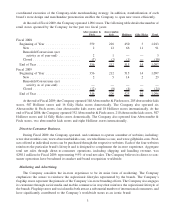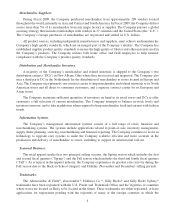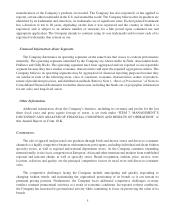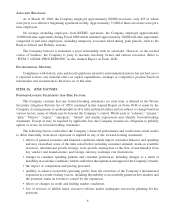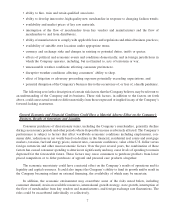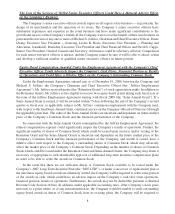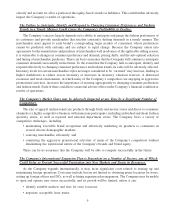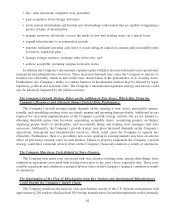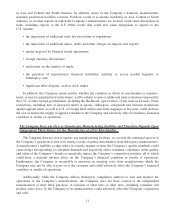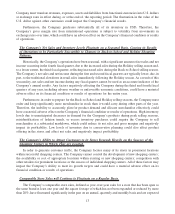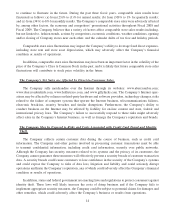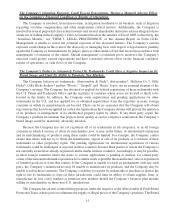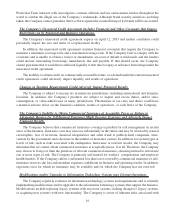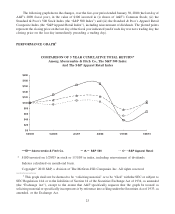Abercrombie & Fitch 2009 Annual Report Download - page 14
Download and view the complete annual report
Please find page 14 of the 2009 Abercrombie & Fitch annual report below. You can navigate through the pages in the report by either clicking on the pages listed below, or by using the keyword search tool below to find specific information within the annual report.
Company must translate revenues, expenses, assets and liabilities from functional currencies into U.S. dollars
at exchange rates in effect during, or at the end of, the reporting period. The fluctuation in the value of the
U.S. dollar against other currencies could impact the Company’s financial results.
Furthermore, the Company purchases substantially all of its inventory in USD. Therefore, the
Company’s gross margin rate from international operations is subject to volatility from movements in
exchange rates over time, which could have an adverse effect on the Company’s financial condition or results
of operations.
The Company’s Net Sales and Inventory Levels Fluctuate on a Seasonal Basis, Causing its Results
of Operations to be Particularly Susceptible to Changes in Back-to-School and Holiday Shopping
Patterns.
Historically, the Company’s operations have been seasonal, with a significant amount of net sales and net
income occurring in the fourth fiscal quarter, due to the increased sales during the Holiday selling season and,
to a lesser extent, the third fiscal quarter, reflecting increased sales during the Back-to-School selling season.
The Company’s net sales and net income during the first and second fiscal quarters are typically lower, due, in
part, to the traditional slowdown in retail sales immediately following the Holiday season. As a result of this
seasonality, net sales and net income during any fiscal quarter cannot be used as an accurate indicator of the
Company’s annual results. Any factors negatively affecting the Company during the third and fourth fiscal
quarters of any year, including adverse weather or unfavorable economic conditions, could have a material
adverse effect on its financial condition or results of operations for the entire year.
Furthermore, in order to prepare for the Back-to-School and Holiday selling seasons, the Company must
order and keep significantly more merchandise in stock than it would carry during other parts of the year.
Therefore, the inability to accurately plan for product demand and allocate merchandise effectively could
have a material adverse effect on the Company’s financial condition or results of operations. High inventory
levels due to unanticipated decreases in demand for the Company’s products during peak selling seasons,
misidentification of fashion trends, or excess inventory purchases could require the Company to sell
merchandise at a substantial markdown, which could reduce its net sales and gross margins and negatively
impact its profitability. Low levels of inventory due to conservative planning could also affect product
offering in the stores and affect net sales and negatively impact profitability.
The Company’s Ability to Attract Customers to its Stores Depends Heavily on the Success of the
Shopping Centers in Which They are Located.
In order to generate customer traffic, the Company locates many of its stores in prominent locations
within successful shopping centers. The Company cannot control the development of new shopping centers;
the availability or cost of appropriate locations within existing or new shopping centers; competition with
other retailers for prominent locations; or the success of individual shopping centers. All of these factors may
impact the Company’s ability to meet its growth targets and could have a material adverse effect on its
financial condition or results of operations.
Comparable Store Sales will Continue to Fluctuate on a Regular Basis.
The Company’s comparable store sales, defined as year-over-year sales for a store that has been open as
the same brand at least one year and the square footage of which has not been expanded or reduced by more
than 20%, have fluctuated significantly in the past on an annual, quarterly and monthly basis and are expected
13


